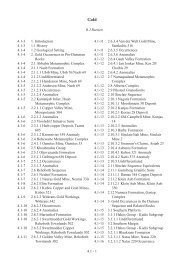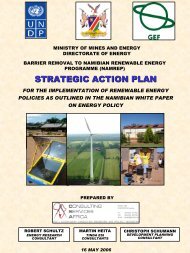Solar PV water pumping study - FINAL REPORT ... - UNDP, Namibia
Solar PV water pumping study - FINAL REPORT ... - UNDP, Namibia
Solar PV water pumping study - FINAL REPORT ... - UNDP, Namibia
You also want an ePaper? Increase the reach of your titles
YUMPU automatically turns print PDFs into web optimized ePapers that Google loves.
Feasibility Assessment for the Replacement of Diesel Pumps with <strong>Solar</strong> Pumps<br />
<strong>FINAL</strong> <strong>REPORT</strong>: September 2006<br />
Table 4.2 lists the number of boreholes for two ranges of constant hydraulic loads. The<br />
potential number of boreholes suitable for <strong>PV</strong>P figures indicates the long term market<br />
potential for <strong>PV</strong>P, assuming that wind pumps, which probably account for 80% of the<br />
technology used on these boreholes, will in future be replaced by <strong>PV</strong>Ps.<br />
Table 4.2: Potential number of boreholes suitable for <strong>PV</strong>P<br />
Hydraulic load<br />
[m 4 /day]<br />
Number of<br />
boreholes<br />
Suitable for<br />
1,000 20,700 Grundfos SQ Flex (1400)<br />
Lorentz Eta<br />
Total Energie TSP 1000<br />
1,000 to 3,000 9,400 Dual Grundfos SQ Flex<br />
(1400) borehole allowing<br />
Total Energie TSP 2000+<br />
During the last five years approximately 670 <strong>PV</strong>Ps were installed (refer to Table 2.2).<br />
Fahlenbock (1996) established that approximately 250 <strong>PV</strong>Ps were installed by 1995.<br />
Assuming that another 400 <strong>PV</strong>Ps were installed between 1996 and 2000 (average of 80<br />
<strong>PV</strong>Ps per year) then the overall number of <strong>PV</strong>Ps installed to date is 1,220.<br />
Although it is unrealistic to assume the figures in Table 4.2 to be the potential market for<br />
<strong>PV</strong>Ps, it nevertheless indicates that there is significant potential for <strong>PV</strong>Ps to replace diesel<br />
pumps and aging wind pumps.<br />
Due to the financial realities as described in section 3 it would be a reasonable scenario to<br />
estimate that the take-up of <strong>PV</strong>Ps over the next ten years will be 20% of the above number<br />
of boreholes. That would result in approximately 6,000 <strong>PV</strong>Ps, which translates to a potential<br />
market of 600 <strong>PV</strong>Ps per annum and would mean that the current installation rate of 225<br />
<strong>PV</strong>Ps (2005) needs to be tripled.<br />
4.2 FINANCING<br />
Financing of renewable energy systems has historically been a challenge as many main<br />
stream banking institutions did not consider RETs as an asset and insurance, a prerequisite<br />
for financing, was often not simple to arrange. This picture has however changed recently<br />
with the activities of the NAMREP programme. At present there are three financing<br />
possibilities, these being:<br />
• <strong>Solar</strong> Revolving fund (SRF)<br />
• Bank Windhoek<br />
• AgriBank<br />
The <strong>Solar</strong> Revolving Fund was set up by the MME in 1996 for the purpose of facilitating offgrid<br />
rural electrification through the use of <strong>Solar</strong> Home Systems. Since 2004 the SRF is<br />
offering loans for <strong>PV</strong>Ps and <strong>Solar</strong> Water Heaters too. The SRF, currently administered by<br />
Konga Investments provides a five year loan repayment period with a 5% deposit against an<br />
attractive interest rate of 5%. At current inflation rates of 4.5% this means that the real<br />
interest rate of the loan is about 0.5%! The SRF has ceiling amounts for each of its loan<br />
categories, which are SHS N$ 30,000, <strong>PV</strong>P N$ 50,000 and <strong>Solar</strong> Water Heaters N$ 30,000.<br />
Page 43 of 76




